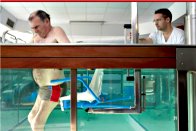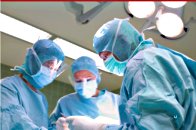Abschnitt 5.2 BGI/GUV-I 506 E - Rehabilitation
Even though accidents and occupational diseases have been reduced impressively as a result of the efforts made, they can never be avoided completely. Should an accident occur in an educational establishment or during salaried or voluntary work, the statutory accident insurance system provides a comprehensive system of support. The principle is that of "rehabilitation before pension". This means that priority is always given to the best possible medical care for the insured person and to their occupational and social re-integration. A pension is paid only when all suitable measures for rehabilitation/ participation have been exhausted.

Info
Keyword: rehabilitation before pension
"Rehabilitation before pension" means that priority is always given to the best possible medical care for the insured person and to their educational/occupational and social re-integration. There is no cap on the costs, since successful rehabilitation is the best solution, for both the insured individual and all other parties. A pension is therefore generally paid only when all realistic and reasonable measures for rehabilitation have been exhausted.
Out-patient care
Following an occupational accident or disease, competent medical care of the insured individual is particularly important. This medical care is delivered "from a single source" under the statutory accident insurance system. Approximately 3,500 accident insurance consultants appointed by the statutory accident insurance institutions provide patients with the necessary care and determine the form to be taken by subsequent treatment. The surgeons or orthopaedic specialists responsible have particular expertise in occupational medicine, and specialist personnel and the latest medical equipment at their disposal.
Services provided in the context of medical treatment
There is no time limit to the medical treatment. It encompasses all suitable measures, in particular:
First aid (rescue)
Medical and dental treatment
Pharmaceuticals and dressings
Treatments, including physiotherapy and kinesitherapy, speech therapy and occupational therapy
Prostheses; orthopaedic and other aids
Load testing and work therapy
Home nursing
For insured persons who require assistance on a considerable scale for certain everyday tasks, nursing care benefits are paid, or home or institutional care services provided.
In-patient treatment
Victims of major injuries or occupational diseases are treated by the accident insurance consultants as in-patients in eleven dedicated clinics operated by the statutory accident insurance system or some 800 additional hospitals which are authorized to provide the relevant medical treatment. If necessary, the insured individuals receive treatment in some 300 approved in-patient rehabilitation clinics or approximately 100 extended ambulatory physiotherapy (EAP) centres. All accident clinics are staffed by highly qualified personnel and feature special wards and the necessary infrastructure. Special rehabilitation centres exist for children and young people who have suffered craniocerebral trauma. These centres feature a hospital school in which children are prepared for their return to their former school or another suitable school.

Extra: the clinics
The statutory accident insurance institutions maintain nine accident clinics, two clinics for occupational diseases, and two accident treatment centres and specialized wards. Their facilities include special departments for the treatment of:
Paraplegia
Severe cerebral injury and burns
Hand injuries and plastic surgery
All accident clinics have wards for intensive therapy and medical equipment employing the latest technology. For fast transport of accident victims, emergency doctors' vehicles and rescue helicopters are on standby at all times. Highly qualified doctors and nursing staff, psychologists, educationalists, occupational and work therapists, physiotherapists, mobility trainers and sports instructors are employed in the clinics; the accident victims thus receive preliminary care and rehabilitation measures under one roof, and can be discharged healthy and ready for work.
The clinics on the Internet: www.vbgk.de

Dr. Roman Feil, consultant, Berlin accident hospital:
"For accident insurance consultants like myself, the number-one rule is that we devote ourselves to protecting our patients and do everything in our power for their best possible rehabilitation."
Occupational and social rehabilitation
Even before injured persons are discharged from the clinics, rehabilitation advisers or case managers from the statutory accident insurance institutions visit them and support them throughout the rehabilitation process. The objective is to ensure that accident victims are integrated back into their educational/vocational and social environment as sustainably as possible.
The focus always lies upon retention of their former workplace. Should a return to the former workplace require further measures or not be possible at all, the statutory accident insurance institutions provide comprehensive alternative support. This occupational assistance is geared to occupational re-integration of victims of accidents or illness, if at all possible sustainably, and in accordance with their ability. It takes into account the insured person's suitability, willingness and previous occupation.
In the case of children and young people, the function of occupational rehabilitation includes all measures necessary to prepare them for school attendance, and to enable them to complete a general education and to train for and pursue a suitable vocation, in accordance with their particular skills and abilities.
Facilitating participation
The statutory accident insurance institutions assume all costs associated with measures for occupational participation. These include the costs of:
Assistance in retaining or finding a workplace
Measures for selecting a vocation, sample work experience, and vocational preparation
Education, retraining and further training
Training courses and study materials
Examinations
Travel, board and lodging
Additional accident insurance benefits may be awarded to schoolchildren:
One-to-one tuition at the hospital bedside or at home, if the future course of education is at risk owing to the duration of schooling lost as a result of the accident
Assumption of the cost of travel to school, in order to ensure the earliest possible resumption of lessons and to avert potential difficulties in keeping pace
Provision of technical tuition and study aids
Provision of schooling in a special training institution for the disabled, including accommodation in a residential or nursing home
Social support is also an element in the social re-integration of schoolchildren or employees following an occupational accident or disease. This assistance furthers participation in community life and takes the form of household, accommodation and vehicle benefits. The affected individuals receive support for example in:
Conversion of their homes (conversion of the sanitary facilities, installation of wide doors, lifts, ramps)
Conversion or purchase of specially equipped vehicles
Digression
The rehabilitation advisor - an example
The task of rehabilitation advisers or case managers at the statutory accident insurance institutions is to provide victims of accidents and disease with measures to facilitate their occupational and social re-integration whilst they are still undergoing treatment and medical rehabilitation. The rehabilitation advisers and case managers organize vocational adaptation and the associated education and training, housing and vehicle benefits; assist in the search for workplaces suitable for employees with disabilities; and provide advice on social problems.
In the words of Christina Gerlach, Head of Rehabilitation Management at the statutory accident insurance institution responsible for the administrative sector: "Supporting the insured individuals is a process which requires close communication. Our task is to manage the process by which the needs of our customers, the insured persons, are translated into actual provision. A specific example: for an insured person who had suffered an accident and was now working as a travel journalist, a work assistant was recruited on the basis of the German Social Code IX (governing rehabilitation and participation of disabled people) to accompany and support him on his trips. In addition, the injured person received work aids, from a height-adjustable desk, through a showercompatible travel wheelchair, to a standing wheelchair. The latter has an important psychological component: "At a party, being able to stand face-to-face with someone else at a high-level table may constitute a major step towards participating in social life."
What does DISABILITY MANAGEMENT actually mean?
In accordance with the concept of "managing disabilities", a person who for example suffers from a chronic disease or the consequences of an injury does not accept this as their fate, but instead makes every possible effort to return to good health and to remain capable of work. In particular, their job should not be lost.
In contrast to other terms, such as "case management" or "disease management", disability management involves an extensive network of parties within the social security system. This network compensates for the deficits which frequently present insurmountable obstacles not only for disabled people themselves, but also for employers.
For further information, visit www.disability-manager.de

